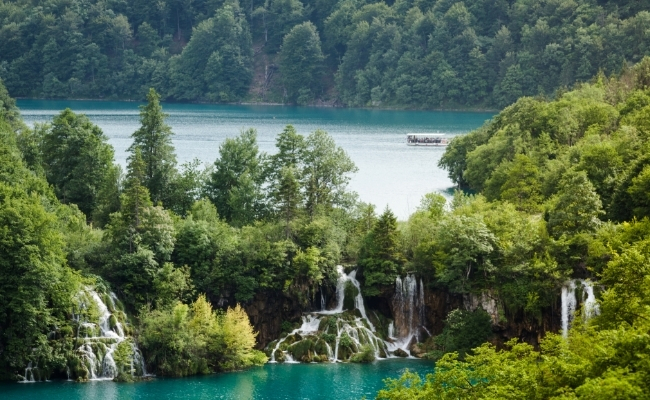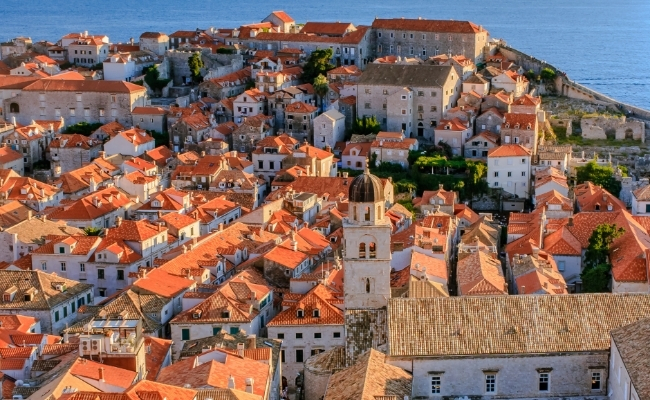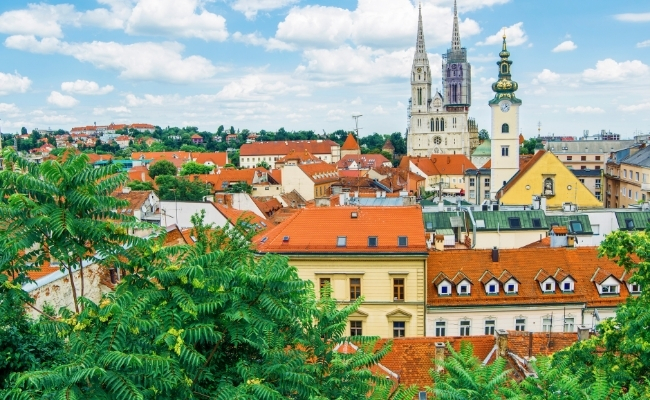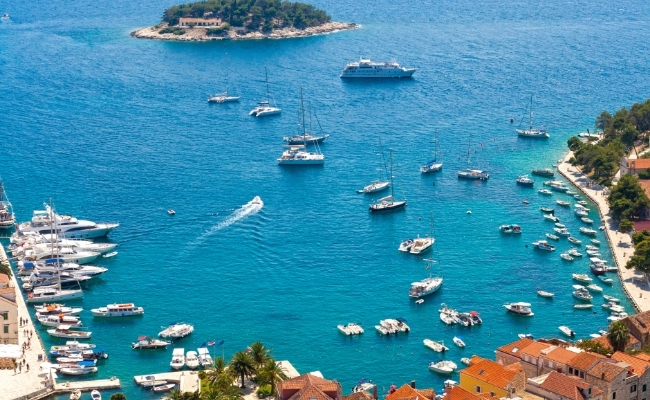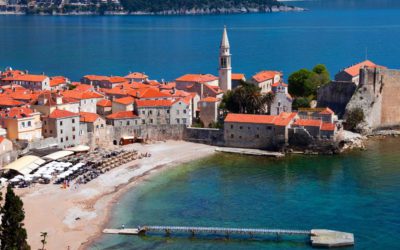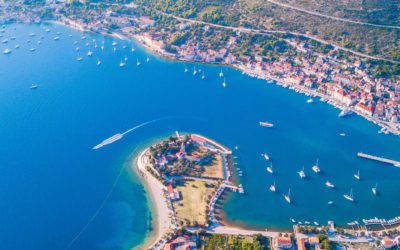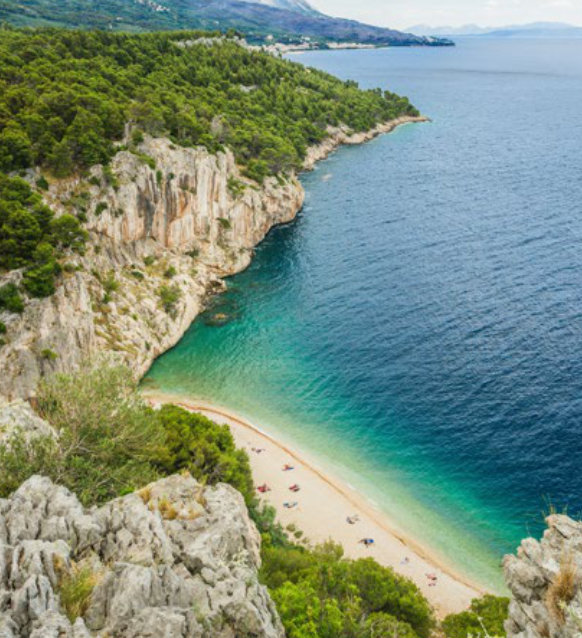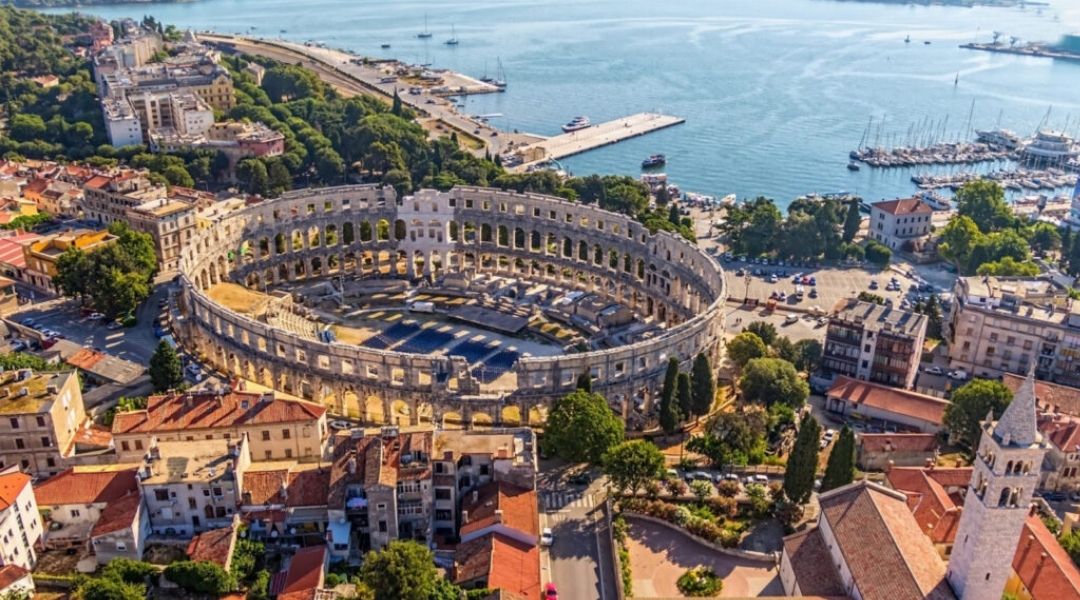Travel With Friends (or Family) – Private Group
Croatia Tours (private journeys) | Family Travel
10 Day Croatia Fun and Active Travel, perfect for you and your private group!
Visiting: ZAGREB – PLITVICE LAKES NATIONAL PARK – SPLIT – HVAR – KORČULA – PELJEŠAC – DUBROVNIK – KONAVLE REGION
We want you to fall in love with Croatia!
Filled with walking tours, outdoor activities as well as time for self-exploration in some of the most beautiful places. This itinerary helps maximize your vacation time as well as create memories to last a lifetime.
Highlights
Itinerary
Day 1: ZAGREB
 Unveil the secrets behind the old facades, discover the hidden courtyards and revive the stories from the past. We’ll give you a completely new perspective of Zagreb City. Walking tour of Zagreb starts with the main square Ban Jelačić, Cathedral, Tkalčićeva street, the Stone Gate, Upper Town, historic center of the city, St. Mark’s Church with the famed multi-colored roof. Using funicular, close to the Lotrščak Tower, you can go down to the Lower town to see a part of the famous Ilica street, the Croatian National Theatre, University and so much more. The Cathedral of the Assumption dominates Kaptol, the glowing towers you see off in the distance are the most immediately recognizable and commanding feature in town. It is an ornate and impressive wonder of neo-Gothic artistry. The cathedral was founded in 1093, heavily damaged in 1242 after various sieges by the Tartars, then again in 1625 after a wave of fires. But the bad luck goes on, in 1880 it was seriously damaged during an earthquake. In 1990 exterior renovations were set in motion to battle against the wearing effects of time. Just up from the main square (Trg Bana J. Jelacica) by the stairs, you will find the colorful Dolac market. To the back of the market square, there are touristy stalls that sell souvenirs. But actually, the market itself is for the locals to buy fresh produce. Downstairs you will find the meat etc. sections.
Unveil the secrets behind the old facades, discover the hidden courtyards and revive the stories from the past. We’ll give you a completely new perspective of Zagreb City. Walking tour of Zagreb starts with the main square Ban Jelačić, Cathedral, Tkalčićeva street, the Stone Gate, Upper Town, historic center of the city, St. Mark’s Church with the famed multi-colored roof. Using funicular, close to the Lotrščak Tower, you can go down to the Lower town to see a part of the famous Ilica street, the Croatian National Theatre, University and so much more. The Cathedral of the Assumption dominates Kaptol, the glowing towers you see off in the distance are the most immediately recognizable and commanding feature in town. It is an ornate and impressive wonder of neo-Gothic artistry. The cathedral was founded in 1093, heavily damaged in 1242 after various sieges by the Tartars, then again in 1625 after a wave of fires. But the bad luck goes on, in 1880 it was seriously damaged during an earthquake. In 1990 exterior renovations were set in motion to battle against the wearing effects of time. Just up from the main square (Trg Bana J. Jelacica) by the stairs, you will find the colorful Dolac market. To the back of the market square, there are touristy stalls that sell souvenirs. But actually, the market itself is for the locals to buy fresh produce. Downstairs you will find the meat etc. sections.

St. Mark’s Church – In the highest area of historic Zagreb this church is characterized by its roof with red, blue, and white representing the coat of arms of Zagreb. The building was constructed by Venetian masters, even the baroque bell tower is an addition of the seventeenth century. Inside there are Gothic vaults and a choir designed by Ivan Mestrovic. The square where it is situated is a symbol of political life because here are the locations of the Sabor (Parliament), neoclassical building, and the Croatian government. The Upper Town, which is the medieval core of the city, developed as two separate (and often warring) towns – Kaptol, the seat of the Bishop (where the imposing Cathedral now stands), and Gradec, the free town where tradesmen and artisans lived (proclaimed by King Bela of Hungary in the 12th century) merged in the 1770s to form the northern section of historic Zagreb. Following this, the city expanded south of today’s Trg Bana Josipa Jelacica (Jelacic Square) to the railway station and the Sava River. Old Town Gate, at the top of Radićeva street (Upper Town). now a shrine to Virgin Mary – the “Kamenita vrata” where you can light a candle or place a vow and, as the locals believe, your wish will be granted. Please be silent and respectful, even if just passing through the Gate. The portrait of Mary is said to be sacred because it is the only thing that survived the great fire in Zagreb in 1731. Near the Old Town Gate is the sculpture of St. George having slain the dragon. The other statue, him fighting the dragon, is located on Marshal Tito’s Square near the Croatian National Theatre.
Strossmayer šetalište. (eng. Strossmayer’s walkway) In the summer, it is an outdoor scene for painters, musicians, and other artists offering food, drinks, performances, and concerts. A popular meeting place for all ages, with a great view of the Zrinjevac Park, (just southeast of the main square), the park of the Academy (connecting the Zrinjevac and Tomislav parks), King Tomislav square, (south of Zrinjevac, just outside the main Train Station), Botanical Gardens, (south of the K. Tomislav Square, near the Hotel Esplanade), Mažuranić square, Square of Maršal Tito, (the green square surrounding the National Theatre).
Itinerary:
- Arrival to Zagreb and a meeting with your driver for a private transfer to your centrally situated hotel in Zagreb Discover Zagreb’s hip craft beer scene on our special tour that not only samples delicious brews but also teaches you fun facts about them. Zagreb and beer, match made in heaven. Visit two breweries and Beer stock market all on a 4-hour tour and find out just how good Croatian craft beer can be. Our first stop is Garden brewery where you will learn all about beer production and taste a variety of beers. Then we will hit Pivana, the oldest brewery in Zagreb. Relax on the beautiful terrace and enjoy a sausage snack with unfiltered beer. Our next stop is Opatovina, a vibrant street stacked with modern pubs. Be sure to check neighboring Tkalčićeva street and visit the Beer stock market. Cheers! The Garden Brewery In the last few years, Zagreb became a place of a true beer revolution. The craft beers made by small breweries have grown so popular that they completely overthrew years of dominance of commercial brewers. Situated in an old red-brick factory in Zagreb’s industrial east, this brewery makes a unique contribution to Croatia’s emerging craft beer scene. Pivana (Zagreb Brewery) While visiting Zagreb there is no way to avoid hoping to at least one of the hotspots that produce and serve incredible flavors of craft beers. This is not a small brewery it’s Zagreb’s oldest commercial brewery, but it recently started producing its craft beer. The place is also known for its stunning terrace, great food offer, and live music. Tkalčićeva Street Always buzzing, the vibrant Tkalčićeva Street is the center of social life in Zagreb located close to Ban Jelačić Square. The street is filled with small restaurants and cafes, boutiques, and souvenir shops located in colorful little houses. This is true tourist heaven since it offers a variety of content for all ages. The fairytale street of Tkalčićeva, which snakes up from focal Jelačić trg, was once the flowing stream of Medveščak. The little side streets leading off it, Splavnica (from splav, raft) and Krvavi most (‘Bloody Bridge’), link to its watery origins and colorful past as the flashpoint in local disputes over the centuries. For two decades, this atmospheric thoroughfare has provided Zagreb with its prime bar crawl, a constant current of revelers moving from spot to spot. Time at leisure and overnight in Zagreb
Day 2: ZAGREB – PLITVICE LAKES NATIONAL PARK
 Plitvice Lakes National Park is Croatia’s best-known national park and the only one of eight that is listed on the UNESCO List of World Heritage sites. The main attractions of this park, are the 16 small lakes joined by waterfalls created by the sedimentation of travertine, a special type of limestone. This national park encompasses the source of the river Korana, located in the area surrounded by dense forests of beech, fir, and spruce. There are also several caves in the park, as well as springs and flowering meadows. The brown bear stands out as one of many protected animal species.
Plitvice Lakes National Park is Croatia’s best-known national park and the only one of eight that is listed on the UNESCO List of World Heritage sites. The main attractions of this park, are the 16 small lakes joined by waterfalls created by the sedimentation of travertine, a special type of limestone. This national park encompasses the source of the river Korana, located in the area surrounded by dense forests of beech, fir, and spruce. There are also several caves in the park, as well as springs and flowering meadows. The brown bear stands out as one of many protected animal species.
The popularity of this park is also boosted by the special means of transport used to ferry visitors around: the panoramic electric trains and the noiseless electro-powered boats. By a network of paths, visitors can get around and access the numerous waterfalls and the rocky lake shores easily.
Itinerary
Breakfast at the hotel and check out Meeting with your tour leader & driver for a private transfer from Zagreb to Plitvice. Enjoy the guided visit to the National Park. The oldest (since 1949) and largest (294,82 km2) National Park in Croatia. The only National Park in Croatia on the UNESCO’s list of protected natural and cultural heritage (for almost 30 years). The riches of sixteen wonderful interlinked azure-green-colored crystalline lakes. The constant formation of the barrier modeled the appearance of the lakes today and is the main feature of the National park. The water of Plitvice Lakes is prime category drinking water (a rarity in Croatia). Dinner is served at a local Plitvice Lakes restaurant. A unique place with an ambiance of a traditional house in Lika, in which authentic dishes are prepared. In the middle of the restaurant, there is an open-hearth fireplace, where lamb is roasted on a spit, and where other food specialties from Lika are prepared “under iron cover”. Ham, “basa” cottage cheese, lamb under iron cover, grilled meats, baked potatoes, trout, sour milk, the Lika fritters, and the Lika strudels made of cheese, apple, or plum, are just some of the specialties of this renowned restaurant. Final drive to your hotel, time at leisure
Day 3: PLITVICE LAKES NATIONAL PARK – SPLIT
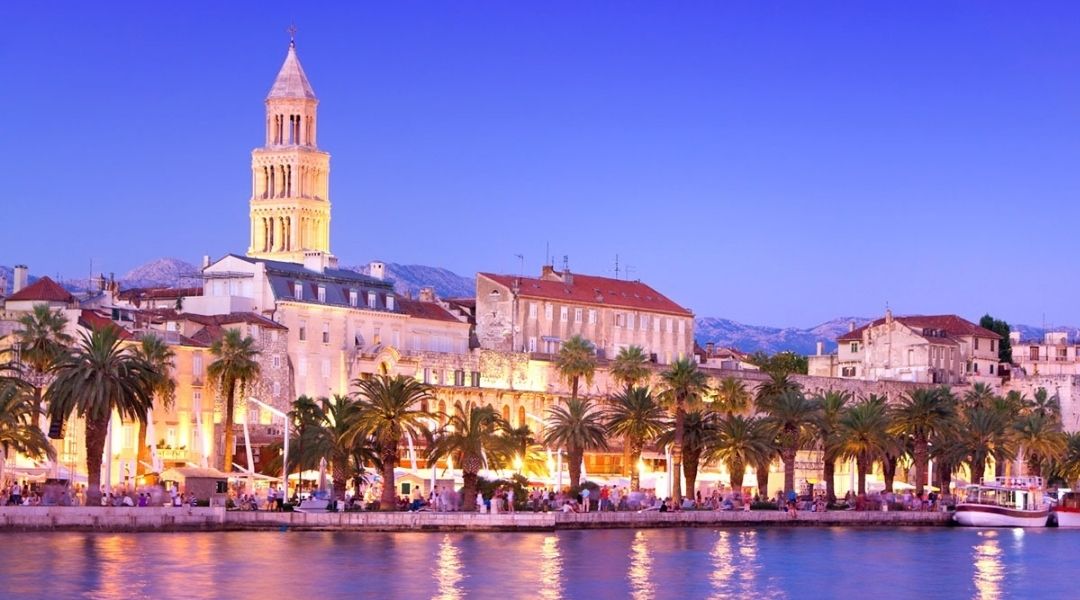
Olives, indigenous aromatic plants, brilliancy of white stone against the verdant vegetation and the towering mountain massif of Biokovo whose spurs reach all the way to the sea – yes, this is indeed an exceptional part of the country, and its beauty is made all the more enchanting by numerous historic events and monuments, and cultural manifestations. When, in the year 305, the Roman Emperor Diocletian, who ruled the entire world at that time, decided to build his leisure time abode – in which he intended to spend the rest of his life – he had no doubt as to exactly where build to it. In the very heart of Dalmatia, in the bay of Aspalathos (Split), well protected from the sea by the islands of the Split archipelago, and defended on its landward side by high mountains, Diocletian created a special point on the map of the Adriatic: the future city of Split. Itinerary: Breakfast at the hotel, and check out Transfer to Split, check into hotel Meet your guide for your Cycling Tour around Split Overnight Split
Day 4: SPLIT
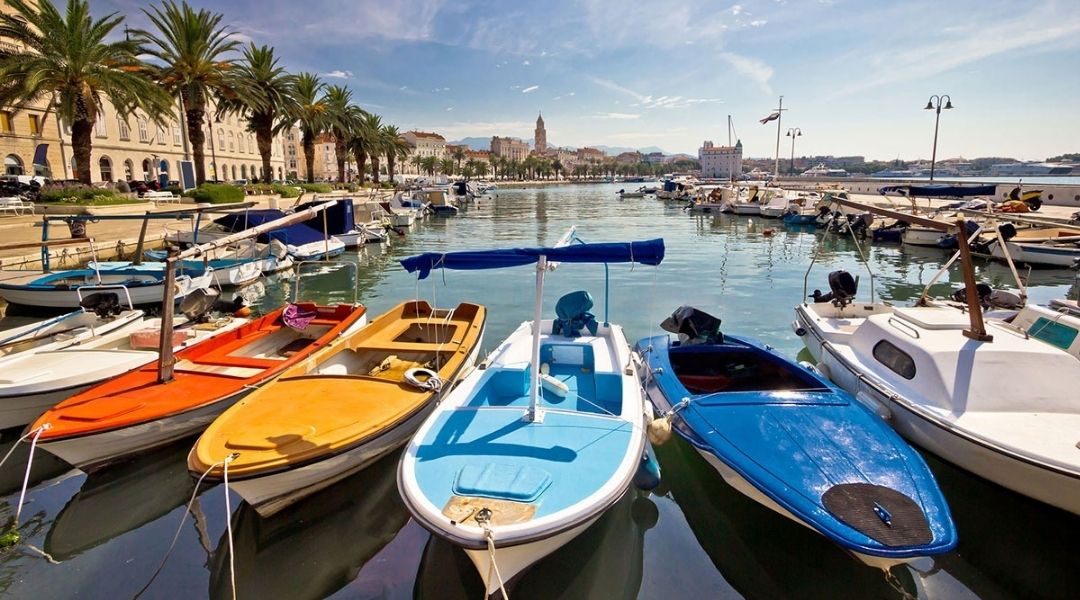
There’s no doubt Diocletian’s Palace is the top must-see attraction in Croatia’s second-biggest city –Split. This UNESCO protected World Heritage Site is actually the heart of the whole city – almost two thousand years old, the enormous palace exists today as a ”living monument” – meaning it’s dotted with quaint shops, galleries, cafes, restaurants, and people actually live and work within its old walls. And that is what makes it really special – it’s an ancient Roman palace absolutely integrated into the everyday life and doings of Split and its people.
The Riva, a marble-white and palm-lined connection of Split and the Adriatic is everyone’s favorite spot for socializing, coffee-drinking or just idle sitting on one of the comfy benches which face the sea. Riva is full of life throughout the day, especially during the summer, and you’ll always find people strolling along or sitting in one of the cafes. So, if you want to get a feeling of the local everyday “buzz” be sure to grab your spot and you’ll soon experience first-hand how important and irresistible is the coffee culture in Croatia.
Marjan hill, often referred to as the “green lungs of the city”, is a big forest park located close to the city center and fully equipped with walking, hiking and jogging trails. It’s a great choice for everyone who prefers less-crowded, wild beaches and thick pine tree shade. Moreover, if you’re looking for a picture-taking paradise, Marjan is your place! It offers stunning views of both Split and the surrounding islands. Marjan also hides some interesting historical sites such as old Jewish cemetery and 15th century monasteries which are actually built into the hill. And finally, maybe not the most important but certainly the yummiest must-do activity of all – food! 😉 Split, especially its Old Town, is literally dotted with colorful food stalls, konoba (a type of traditional Dalmatian tavern) and quaint little restaurants. Don’t miss local delicacies, such as fish prepared na gradele and pašticada. Street food culture in Split is also pretty strong and you can never go hungry since there’s always some inviting bite-sized treat waiting for you around the corner. Breakfast at the hotel and a day at leisure to explore the city on your own The second-largest city in Croatia, Split (Spalato in Italian) is a great place to see Dalmatian life as it’s really lived. Always buzzing, this exuberant city has just the right balance of tradition and modernity. Step inside Diocletian’s Palace (a Unesco World Heritage site and one of the world’s most impressive Roman monuments) and you’ll see dozens of bars, restaurants and shops thriving amid the atmospheric old walls where Split life has been going on for thousands of years. Join your local host for the Rakija tour. This tour will take you to the best places in the city center where you can meet locals and taste local liquor – Croatian grappa or rakija. Along with rakija tasting, you will walk through 1700 old town of Split. We will take you to cool places around Split and give you opportunity to see how locals have fun and learn more about origin of rakija. *Rakija %92%92ˈräkē(y)ə%92%92 stands for fruit brandy, popular liquor in Croatia.
Barhop around the Palace The Diocletian’s Palace is the perfect backdrop for Croatia’s best bar crawl, a night of revelry in the secret alleyways and hidden corners of this atmospheric ruin overlooking the seafront. Certain bars stand out amid the blur – though whether you’ll be able to find them the next night is another matter. In fact, retracting your footsteps, or trying to, is half the fun. In any case, do look out for Charlie’s Bar, To je to, Figa, Gaga, and the long-established Academia Ghetto Club. If you just want to sit down for ten minutes and observe, then the little hub on Majstora Jurja containing Teak and Na Kantunu should do nicely.
Gawp at an Adriatic sunset Split’s focal embankment, officially titled Obala Hrvatskog Narodnog Preporoda, the Riva is where the city meets over coffee. As the sun moves across the sky, and thoughts turn to the night ahead, customers on the dozen or so café terraces tend to start ordering stiff drinks rather than coffee. Order up a cold drink, maybe a signature doorstep sandwich of prosciutto and cheese, and take in the last of the day’s rays. An overnight in Split
Day 5: SPLIT – HVAR

The lavender island that Conde Nast’s signature travel magazine called “one of the “best 10 islands in the world”. A vacation on the lavender island of Hvar means extraordinary experiences every day – from visiting an ancient olive grove and learning about what Homer called “liquid gold”, taking a Jeep safari to discover hidden inland Hvar to exploring a castle, visiting the oldest theatre in Europe or tasting spectacular wine and local delicacies at an award-winning vineyard. The gently rolling hills, spectacular beaches, lush vineyards, and vibrant nightlife of Hvar make it the perfect island getaway. Take a stroll down the medieval streets of this lovely island and you will encounter imposing fortifications that testify to the island’s ancient history.
St. Stephen’s Square – The center of town is this rectangular square, which was formed by filling in an inlet that once stretched out from the bay. At 4500 sq meters, it’s one of the largest old squares in Dalmatia. The town first developed in the 13th century to the north of the square and later spread south in the 15th century. Notice the well at the square’s northern end, which was built in 1520 and has a wrought-iron grill dating from 1780.
Cathedral of St Stephen – The cathedral forms a stunning backdrop to the square. The bell tower rises four levels, each more elaborate than the last. The cathedral was built in the 16th and 17th centuries at the height of the Dalmatian Renaissance on the site of a cathedral destroyed by the Turks. Parts of the older cathedral are visible in the nave and in the carved 15thcentury choir stalls.
Renaissance Theater – Built in 1612, this theatre is reportedly the first theatre in Europe open to plebeians and aristocrats alike. It remained a regional cultural center throughout the centuries. Plays were still staged here right up until 2008. Although much of the theatre is still under renovation, you can wander around the atmospheric interior and take in the faded frescoes and baroque loggias.
Franciscan Monastery & Museum – This 15th-century monastery overlooks a shady cove. The elegant bell tower was built in the 16th century by a well-known family of stonemasons from Korčula. The Renaissance cloister leads to a refectory containing lace, coins, nautical charts, and valuable documents, such as an edition of Ptolemy’s Atlas, printed in 1524. Your eye will immediately be struck by The Last Supper, an 8m by 2.5m work by the Venetian Matteo Ingoli dating from the end of the 16th century. The cypress in the cloister garden is said to be more than 300 years old. The adjoining church, named Our Lady of Charity, contains more fine paintings such as the three polyptychs created by Francesco da Santacroce in 1583, which represent the summit of this painter’s work. Fortica – Through the network of tiny streets northwest of St Stephen’s Square, climb up through a park to the citadel built on the site of a medieval castle to defend the town from the Turks. The Venetians strengthened it in 1557 and then the Austrians renovated it in the 19th century by adding barracks. Inside is a tiny collection of ancient amphorae recovered from the seabed. The view over the harbor is magnificent, and there is a lovely cafe at the top.
Arsenal – On the southern side of St Stephen’s Square, the Arsenal was built in 1611 to replace a building destroyed by the Ottomans. Mentioned in Venetian documents as ‘the most beautiful and the most useful building in the whole of Dalmatia’, the Arsenal once served as a repair and refitting station for war galleons. Itinerary: Breakfast at the hotel and check out Assistance with your luggage and private transfer from your hotel to Split Port Fast ferry from Split to Hvar Upon arrival to Hvar assistance to your hotel is provided by the hotel representative waiting for all the hotel guests at the pier in Hvar Port holding a hotel signboard Check into your hotel and explore its facilities and the area on your own (early check-in not guaranteed) Meet your guide and depart on a special wine tasting tour of Hvar. Taste Croatia’s first and only wines that won the Paris World Wine Contest and the Decanter World Wine Awards in London! Our Taste of Hvar, the island of wine tour introduces you to one of Croatia’s most distinguished winemakers, including wine tastings. Return to Hvar town for time at leisure and overnight in Hvar
Day 6: HVAR
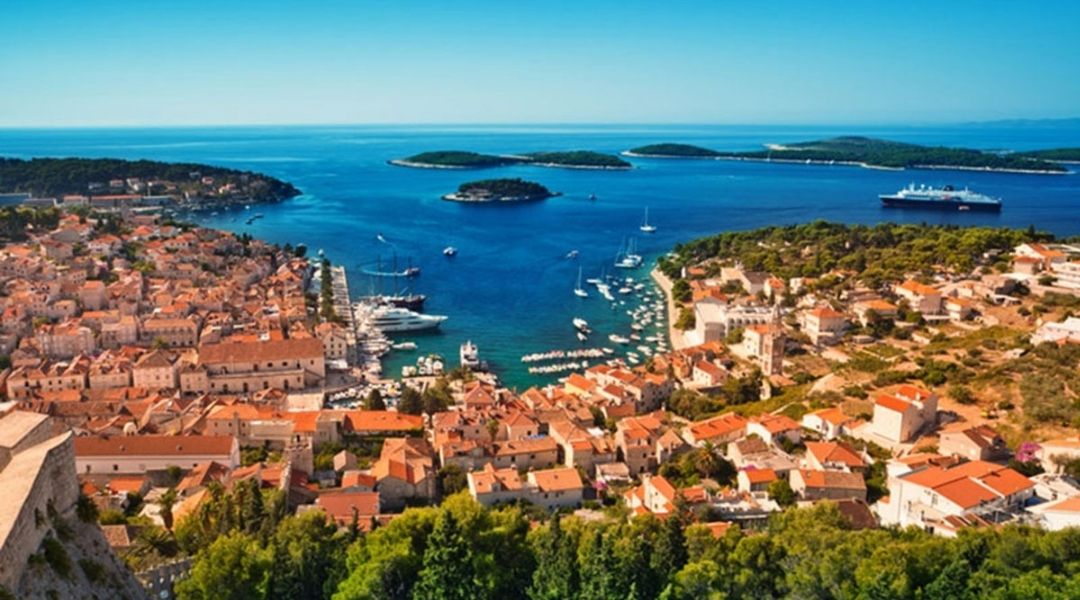
Pakleni islands archipelago, a labyrinth of several smaller islands that offer perfect bays for swimming and snorkeling. Paklinski islands group are situated in front of Hvar town and they tend to use like a large town park and town port breakwater. Pakleni island with its many coves is the perfect place for famous people who want to hide from publicity and keep their own privacy.
The Island group is covered with low vegetation, small bushes, and alepp pine. There you cannot find many pebble or sandy beaches, but the interesting spot has beach chase, beach bean bag or other kinds of beach chairs. Entire Vinogradišće bay has a sandy bottom and the sea color is beautiful. In Vinogradišće you could enjoy in the narrow, not-too-long sandy beach with beach chairs. 50 meters distance from the sandy beach there is a small pebble beach. Behind restaurants, you can find many shady trails which lead in different directions. Land and facility owners take care that everything remains in harmony with nature (and they expect from tourists the same). The same philosophy you will notice on the other spots on Paklinski islands – Marinkovac with isthmus Zdrilca (pebble beach), Vlaka bay, and Soline (sandy beach).
Itinerary
Breakfast at the hotel Meeting with your skipper for a private half-day sail from Hvar to island to Pakleni islands – perfect places to lie on the sun and swim in peace, maybe enjoy lunch and a cocktail in one of the secluded lounge bars and restaurants (Zori or Laganini restaurants) Final sail to Hvar island and time at leisure to explore the town center on your own. As the sun sets down, Hvar becomes alive with people; we recommend a cocktail at one of the numerous bars and terraces around the beautifully illuminated harbor. Experience the best party hotspot of Hvar on one of the nearby terraces. Chill and relax with different aperitifs and smooth jazz music or live bands. Elegant and well-dressed couples, as well as families, stop for a drink as an introduction to a delicious dinner in one of Hvar´s fabulous restaurants or as a start for a long and exciting party night. Time at leisure and overnight in Hvar
Day 7: HVAR – KORČULA

Korčula was first mentioned as early as the 10th c. in works of Byzantine historians under the name “Stone Town”. It flourished under the Venetian government and later it spread around the town walls. But in spite of all that, it is still the most famous as the birthplace of Marco Polo who was probably born here in 1254, and reminders of him can be seen all around the town, including the extremely interesting Marco Polo Museum which is something you definitively don`t want to miss when visiting this beautiful Dalmatian town.
Today it`s a town where you can vividly feel the Mediterranean spirit of people who live and work in this mixture of Gothic, Renaissance, and Baroque architecture. Itinerary: Breakfast at the hotel and check out Assistance from the hotel to Hvar Port provided by the hotel staff Embark the fast ferry from Hvar to Korčula Upon arrival to Korčula, you will be assisted to the hotel Korčula, the birthplace of the famous explorer and adventurer Marco Polo. Surrounded by medieval walls, Korčula resembles a miniature Dubrovnik when approaching from the sea.
The town has more legends, tales, and monuments than you can find anywhere else. Explore the town of Korcula with its long history, ingenious building strategies, peculiar building layout, and a legend of a great merchant traveler Marco Polo that was born and spent his childhood in the streets of Korcula. Today, Korčula is the only place in the world where the Spanish medieval Knight’s game – Moreška – is still performed and you’ll have the pleasure of enjoying the open-air performance Time at leisure and overnight in Korčula.
Day 8: KORČULA – PELJEŠAC – DUBROVNIK

Ston is a small Mediterranean town situated on the Pelješac Peninsula, with a history that reaches back as far as the 14th century. It is a small town with the longest stone wall in Europe(5,5km), with narrow quiet streets, noble ancient houses, and traces of ancient cultures. Its former value as a “salt city” gets confirmed even today in the plants of the oldest active salt-works in the world. These saltworks have remained faithful to the tradition and to the natural way of salt production which has not changed since remote ages. The town is best known for its oyster and mussel beds, and during your tour, you will not only participate in oyster harvesting but also be served fabulous versions of these shellfish along with traditional dish buzara for light lunch. Pelješac peninsula is renowned for its spectacular coastline and historic towns and wine production. Enjoy the magnificent peninsula scenery and picturesque vineyards. You can start this tour with a visit to Ston, a town famous for its 5 km long defensive wall, the second largest in the world, right after the Chinese wall, and finish in Mali Ston, the center of oyster production in Croatia.

Dubrovnik is a medieval city on the Croatian side of the Adriatic coastline and a treasure trove of cultural, historical monuments that were created throughout its thousand-year existence. In the past, it was a City-Republic, and alongside Venice one of the most famous cultural-economic centers on the Mediterranean. In more recent times, it has become the center of modern cultural and tourist events: a city of summer festivals – an international parade of top musical and theatrical achievements, a city of museums and galleries. These values have turned Dubrovnik into a place that offers a rich selection of various experiences and excitement, and also a complete holiday in a quiet and calming, mild Mediterranean ambiance, and wonderful seaside landscapes.

Itinerary
Your half-day adventure at the Adriatic Sea starts beneath ancient fort Lovrjenac in the small port called Pile, next to restaurant Orhan. Accompanied by English-speaking instructors (tour guides), you will set off to explore the caves and beauties of the mysterious Dalmatian coast. You will enjoy in private & unique view of the City walls and you will discover the richness of the Adriatic underwater. After a short break on the beach, you will paddle along the coast toward the City walls. Beaches, palm trees, boats, villas, and hotels… form part of this tour. Paddling under the impressive city walls and rocks on which they were built, you will enjoy breathtaking views of the Pearl of the Adriatic from a different perspective. Unquestionably the most beautiful part of our sea adventure. Finish paddling toward the initial position in the Pile bay. Distance between the start position and finish point: 7km Duration of the tour: 3h Fitness level: A low level of fitness is required. Previous experience: Not necessary. On-site facilities: There are no toilet facilities available during the tour only the public ones on Pile Square. Special Conditions: Guides reserve the right to cancel the trip, without prior notice, in case of bad weather conditions. It is necessary to comply with all safety instructions by the team. In addition, guides retain the right to change the route. Itinerary: Breakfast at the hotel and check out Meet your driver for a private transfer from Korčula to Dubrovnik with an en-route stop in the town of Mali Ston, home to Croatia’s most delicious oysters, carefully grown in beds throughout the bay. A local oysterman will harvest them right out of the sea for you to enjoy on the spot! As the car heads to the highway, you will have a great opportunity to enjoy the picturesque hillside of Dalmatia’s magical interior: a unique blend of high mountains and small patches of fertile fields. It is part of the country that looks as if it was stopped in time. Upon arrival in Dubrovnik check into your hotel and refresh Meeting with your instructors at Pile Gate for a group half-day sea kayaking experience (starts beneath fort Lovrjenac in the small port called Pile). Explore caves and beauties of the coast, where you will have a break for snorkeling and swimming. Upon return, discover why easy paddling in kayaks beneath the old city walls. Time at leisure and an overnight in Dubrovnik
Day 9: DUBROVNIK – KONAVLE – DUBROVNIK

Stradun – the main street of Dubrovnik where everyone walks and the busiest street where you stroll over marble tiles. Stradun is a great place for everyone where all the shopping can be done, cafes and restaurants are in the streets and many wonderful shops. Onofrio’s Fountain – this drinking fountain is located just at the beginning of Stradun, the main street of the old town. The structure was named after its builder, the Italian Onofrio de la Cava, dates from 1440 and includes 16 sides. The concept is part of the water supply system of the city and brings water from the well in Rijeka Dubrovacka, at more than 20 km away, to the heart of the city. Before that this interest was, therefore, more than a masterpiece of architectural sophistication. Originally the fountain was decorated with a sculpture, which was destroyed in the earthquake of 1667, the Remaining 16 stone masks from which the water flows into a lake. The Clock Tower was built in the 15th Century right at the other end of the Placa (main thoroughfare) and represented alongside nearby buildings a free city-state. The tower is approximately 31 meters in height and built by Grubacevic, Utisenovic and Radoncic, local masters. Following an earthquake, the structure of the Clock Tower lost its structure and leaned. For it not to fall the Clock Tower was rebuilt in 1929. Orlando’s column was built in 1418, then it was the focal point of the city and Government ordinances and punishment carried out. A flag flies above the statue with the ‘Libertas’ motto. The medieval cult of Orlando (Roland) started here in the 12th century based upon the epic poem ‘Song of Roland’

The Konavle region stretches from Cavtat to the border with Montenegro. The village of Čilipi close to the airport is one of the cultural centers of Konavle, and on Sunday mornings you can witness the traditional songs and dances of Konavle and performers dressed in colorful folk costumes. Konavle consists of a fertile valley plus upland and coastal parts, all with stone villages. In the central valley, you’ll find traditional rural restaurants where you can enjoy delicious home-grown food – locally reared meat and trout, sometimes served by waiters and waitresses in traditional costume. The upland section borders with Herzegovina, for centuries the dividing line with the Ottoman Empire. There are well-marked hiking trails, and organized trips include a hearty meal as part of the deal. The protected landscape surrounding the Ljuta is home to a watermill and stamp system, which consists of eight flour mills, two oil mills, and three stamp mills. Part of this system, called the ‘lower mills’, was built after 1550, when Konvale came to be under the control of the Republic of Dubrovnik. The lower mills have been preserved until today.
Agritourism offers the visitors an opportunity to familiarize themselves with agricultural areas, rural farm activities, local products, traditional cuisine and the daily lives of the local inhabitants. Dubrovnik visitors can experience cultural elements of the region, while showing respect for the environment and tradition. Other than for entertainment purposes, Agritourism also brings the visitor closer to nature and rural farming activities, which the visitor can then participate in and experience the joys of adventure, discovering and learning. Obtaining the necessary ingredients and preparing traditional meals, dishes and refreshments with help of the hostess of the house, listening to stories about the people and the land during dinner is what awaits you. Itinerary: Breakfast at the hotel Experience the best of both worlds- follow in the footsteps of your favorite characters from the pop culture influencing and immensely popular Game of Thrones and see both Dubrovnik city historical highlights and the of Dubrovnik on this 1.5-hour guided walking tour. This two-in-one tour gives you everything: you revisit the scenes of the most famous events filmed in Dubrovnik, also known nowadays as King’s Landing, whilst also getting an insight into a millennium of interesting history that made Dubrovnik one of the most significant places in the known world at it’s prime. Dubrovnik was the perfect choice as the setting for the capital in Game of Thrones – not only does it have stunning natural and historical locations, but the real-life history of the city can often compete with King’s Landing for political intrigue and strange stories. Walk around Dubrovnik Old Town and visit GOT film location sites from the latest season and listen to an amazing commentary from your guide. Look at A4 photos that show the screenshots from appropriate episodes to put it all into context. Time at leisure to explore on your own Meet with your driver for a half-day cooking class in the Konavle area with a traditional meal. Learn how to prepare homemade food the same way our ancestors did centuries ago. After meeting in Dubrovnik, we will drive along amazing coastline stopping on several panoramic points to take unique photos of Dubrovnik and its surroundings, with a visit to an old flour mill or an olive press instead.
Upon arrival to a typical rural villa, welcome drinks and snacks will be served. You may pick fresh vegetables for your cooking lesson straight from our garden! Depending on the season, you’ll prepare meals like “sac” – lamb or veal cooked under the iron bell; “zelena menestra” – green cabbage with dry meat; skewers on laurel sticks; smoked bacon and goat cheese… Prepare your meal over the open fire, dig your fingers into the fresh dough, taste some olive oil, and blend it in rural ambiance to get the true feeling of Dubrovnik countryside. This tour is created to present the local ambiance and the authentic feeling of life in the village. Return to Dubrovnik for an overnight
Day 10: DUBROVNIK
Check out and a private transfer from Dubrovnik to Dubrovnik International Airport for a departure flight.

This package includes:
- VAT TAX INCLUDED
- 24hr concierge and in Croatia assistance
- English speaking tour leader throughout
- Private transfer from Zagreb Airport to your hotel in Zagreb in a modern, air-conditioned vehicle
- Private Zagreb brewery tour (Included: Licensed tourist guide, Transport as per program, Guided visit of Garden brewery (try the few varieties of beer from lager to stout), production accompanied with beer tasting, Visit at the oldest brewery in Zagreb with a traditional snack and tasting (sausage snack is being served with unfiltered beer), First round of beer in brew stock market)
- 1 night in a 4* hotel in Zagreb, double room, BB basis
- Private transfer from Zagreb to Plitvice Lakes NP in a modern air-conditioned vehicle
- Entrance fees to the NP Plitvice Lakes and a guided visit/hike
- 1 night in a 4* hotel in Plitvice area, double room, BB basis
- Accommodation for the driver in Plitvice Lakes area
- Private transfer from Plitvice Lakes NP to Split in a modern air-conditioned vehicle
- Split group cycling tour (The price includes: Equipment – Premium serviced bikes, Trek or Fuji trek hybrids for all heights, insurance, guide assistance)
- 2 nights in a 4* hotel in Split, double room, BB basis
- Rakija Tour Split (Includes: free rakija shots in different bars around Split old town center, Short sightseeing tour with English speaking tour guide)
- Assistance with your luggage from your hotel to Split Port
- Fast ferry tickets for transfer from Split to Hvar
- Hvar wine tasting – Included: pick up, guide/driver, car transfer, wine tasting.
- NOTE: Hvar wine tasting tour includes one of the wineries. You will have the opportunity to taste 4 – 5 different wines together with a specific wine guide, who will describe the individual wines and provide all information needed with islands finest local appetizers.
- 2 nights in a 4* hotel in Hvar, double room, sea view, BB basis
- Half day sailboat excursion to Pakleni islands (Included: skipper, charter, welcome drink)
- Fast ferry tickets from Hvar to Korčula and assistance with your luggage to/from port
- Private walking tour of Old Town Korcula with tasting of traditional cukarin cakes
- Entrance fees for the Moreška performance
- 1 night in a 4* hotel in Korčula, double room, BB basis
- Private transfer from Korčula to Dubrovnik with en route stop in Ston in a modern air- conditioned vehicle (entrance fee to Ston Walls included)
- Oyster harvesting and typical local lunch with the local oystermen
- Group sea kayak experience in Dubrovnik (kayaking & snorkeling gear, waterproof barrels for personal things, instructors/guides, insurance)
- 2 nights in a 4* hotel in Dubrovnik, double room, sea view, BB basis
- Game of Thrones and Dubrovnik group tour (Included: English speaking guide)
- Half day group cooking class in Konavle Valley followed by a meal in a local rural estate (Cooking class includes:transportation, welcome drink & snacks, all food & drink served during the class) with round trip transfers
- Private transfer from your hotel to Dubrovnik Airport in a modern, air-conditioned vehicle

The program does not include:
- Meals and drinks not mentioned above
- Airfare
- Travel Insurance
- Additional excursions and/or services not mentioned in the program
- Personal expenses (internet, telephone, mini bar, etc.)
- Tips and porterage services
OPTIONAL
- Fishing private tour
- Included: fishing license, fishing equipment, professional skipper, fuel, hotel pick up / drop off, soft drinks on board, towels, VAT
Dates and Pricing
PRICES FROM
Prices are based on number of passengers traveling and dates of travel
TRAVEL BETWEEN
May – September
AVAILABLE DATES UPON REQUEST
Double Occupancy Cabins
Solo traveler with supplement
